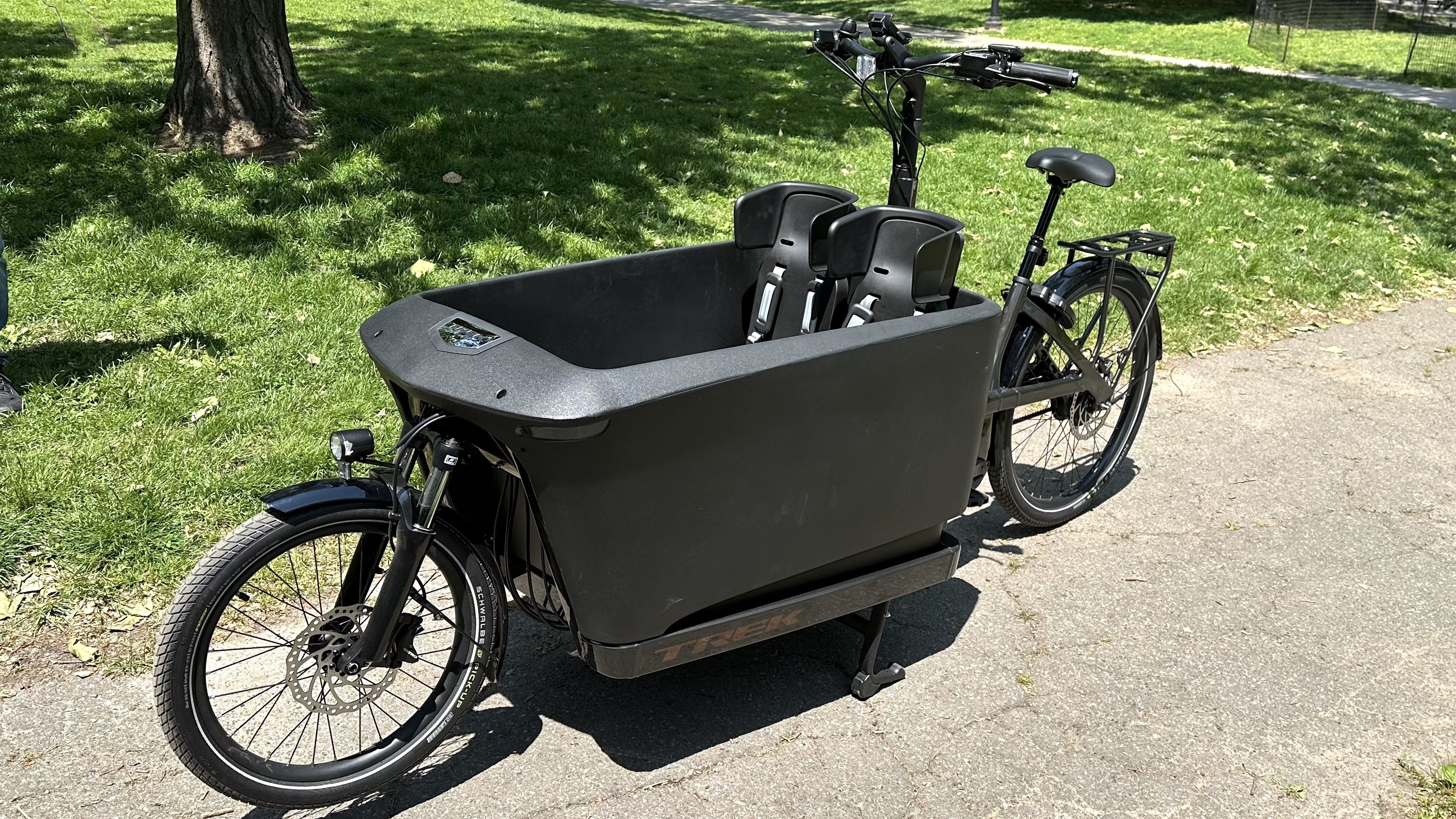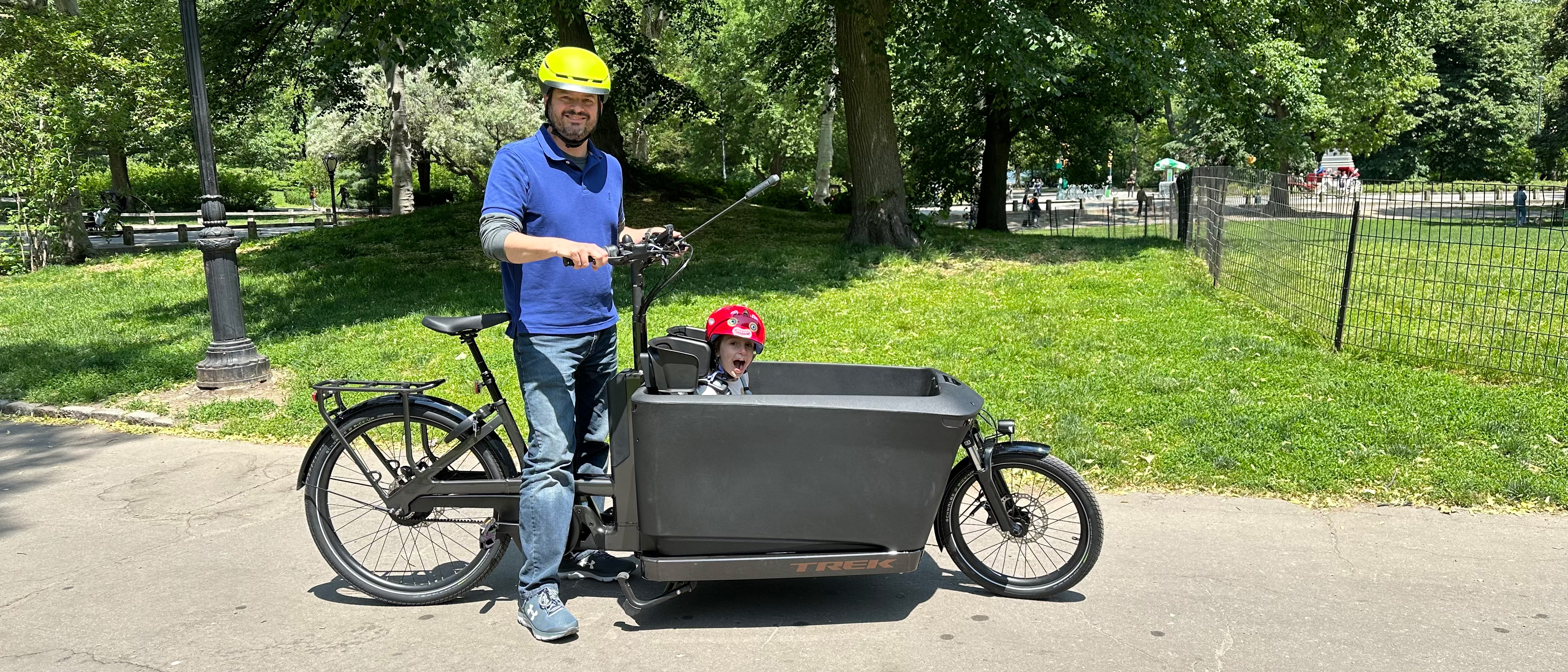Early Verdict
The Trek Fetch+4 is the company's first cargo ebike. It's well-designed but goes up against a number of well-established players.
Pros
- +
Can carry a lot of cargo
- +
Easy to pedal
- +
Lots of configuration options
Cons
- -
No throttle
- -
Cargo area design is a bit bland
Why you can trust Tom's Guide
Trek has been a well-known bike brand for decades — I still have my Antelope 830 from 30 years ago (and recently converted it to an electric bike) — but until now, the company hadn't released an electric cargo bike.
It seems Trek is making up for lost time with two new models, the Trek Fetch+2 and the Trek Fetch+4, both of which promise enough hauling capacity to replace your car. Both models recently went on sale for $5,999 and $8,499, respectively.
Trek offered me the chance to take one of its cargo bikes for a ride through Central Park in New York to see how it compared to some of the best electric bikes. And, because they're meant to tote tykes, I brought along my daughter to see what she thought of the bikes, too.
Trek Fetch+2 and Fetch+4 pricing and availability
Both the Trek Fetch+2 and Fetch+4 went on sale in May 2023; you can find them on Trek's site and Trek dealers throughout the U.S.
The Fetch+2 costs $5,999, and is available in blue, red, or gray. The Fetch+4 costs $8,499, and comes in red or black. Both come with a 30-day money back guarantee.
Both bikes come in only one size, but can be customized with a number of seats, panniers, and racks. The options aren't as extensive as what RadPower offers with its electric bikes, but there's plenty of choices.
Trek Fetch+2 and Fetch+4: Specs

The Trek Fetch+2 and Fetch+4 have different designs, and different carrying capacities as a result. The Fetch+2 is designed so that you carry the bulk of the load behind the rider, whereas the Fetch+4 has a large cargo area in front of the rider, and can carry more stuff in general.
Get instant access to breaking news, the hottest reviews, great deals and helpful tips.
| Row 0 - Cell 0 | Fetch+2 | Fetch+4 |
| Price | $5,999 | $8,499 |
| Weight | 68.35 lbs | 165.35 lbs |
| Weight limit (rider+ cargo) | 373 pounds | 386 pounds |
| Capacity (kids) | 2 | 5 |
| Battery | 500Wh | 750Wh |
| Motor | Bosch Cargo Line (250W, 85Nm) | Bosch Cargo Line (250W, 85Nm) |
The Fetch+2 is the smaller and less expensive of Trek's e-cargo bikes; a rack in the rear of the bike can hold up to two kids, and you can also configure the bike with two rear panniers and two in the front, on either side of the front wheel.
Trek says that the larger Fetch+4 can fit up to four kids (max total weight of 175 pounds) in its front cargo area, but those kids would have to be pretty small; after seeing the bike in person, you could get away with four 3-foot toddlers, but even that would be kind of a tight squeeze. You can outfit the bike with individual seats for each kid, a bench seat, or even an infant-style car seat. The rear rack can hold up to 59 pounds.
Both models use a Bosch Cargo Line 250W hub motor, but the Fetch+2 has a 500Wh battery to the Fetch+4's 750Wh battery. Both batteries are removable, so you can recharge it separate from the bike itself.
The Fetch+4 uses a Enviolo Pro Manual Controller twist shift, while the Fetch+2 has a 10-speed Shimano Deore M4100 for changing gears. Both bikes also have 4-piston hydraulic disc brakes, as well as a dropper seat post.
The Fetch+4 has a 27.5-inch rear wheel and a 20-inch front wheel, which is turned via cable steering. Trek adjusted it so you don't have to turn the handlebars too far — a 65-degree handlebar turn will rotate the front wheel 85 degrees. Like most cargo bikes of its ilk, it's pretty large, measuring more than seven feet in length.
Trek Fetch+4: Performance

To test the Fetch+4, I loaded it up with my backpack and my daughter and took it for a spin around the north half of the Central Park loop. As with any cargo bike, getting used to its weight distribution took a few minutes — you want to make sure all your turns are nice and gradual — but once I got going, things felt pretty steady.
The Bosch mid-drive motor was plenty powerful to get me around Central Park — even going up the hill at the north end was no effort at all, and I cruised past others who didn't have the benefit of pedal-assist. While the bike offers five levels of pedal assist, there's no throttle, which is a feature that's useful if you're trying to get a cargo bike moving from a stop while you're on a hill.
On the right handlebar is an Enviolo grip shift, which is used to change gears; I wasn't a huge fan, as it was hard to get a sense of how far I should turn it to change gears.
One welcome feature that I wouldn't have figured on was the bike's dropper seat post. Similar to one of the best office chairs, I pressed a lever on the handlebar to raise the seat height to a comfortable level. That made it so much easier to get on and off the bike.
Compared to some other electric cargo bikes, the cargo area of the Fecth+4 is a bit bland. It's a large, functional piece of plastic that looks like it will hold up to plenty of bumps and knocks, but it lacks the design pizzaz of the bamboo used in the Yuba Supercargo CL or the Bunch Coupe. At least there's plenty of room for stickers.
Trek Fetch+4: Outlook

While I haven't ridden the Fetch+4 enough to give it a full review, my test ride gave me the impression that it's a strong first effort by Trek in the electric cargo bike category. However, it faces a lot of stiff competition from well-established rivals.
For instance, the Yuba Supercargo CL — which is the best cargo bike on our list of the best electric bikes — weighs half as much as the Fetch+4, but can tote up to 220 pounds in its front cargo area, plus another 80 pounds in the rear. And, at $5,999, it costs more than $2,000 less than the Trek.
Still, the Fetch is a relative bargain compared to the Riese & Mueller Packster 70, which starts at $9,279; you'd have to upgrade to a $10,250 model to get a similar belt drive and shifting system as the Fetch+4.
As for my daughter? She had a blast, but was more excited about all the snacks I put in the seat next to her.

Michael A. Prospero is the U.S. Editor-in-Chief for Tom’s Guide. He oversees all evergreen content and oversees the Homes, Smart Home, and Fitness/Wearables categories for the site. In his spare time, he also tests out the latest drones, electric scooters, and smart home gadgets, such as video doorbells. Before his tenure at Tom's Guide, he was the Reviews Editor for Laptop Magazine, a reporter at Fast Company, the Times of Trenton, and, many eons back, an intern at George magazine. He received his undergraduate degree from Boston College, where he worked on the campus newspaper The Heights, and then attended the Columbia University school of Journalism. When he’s not testing out the latest running watch, electric scooter, or skiing or training for a marathon, he’s probably using the latest sous vide machine, smoker, or pizza oven, to the delight — or chagrin — of his family.

